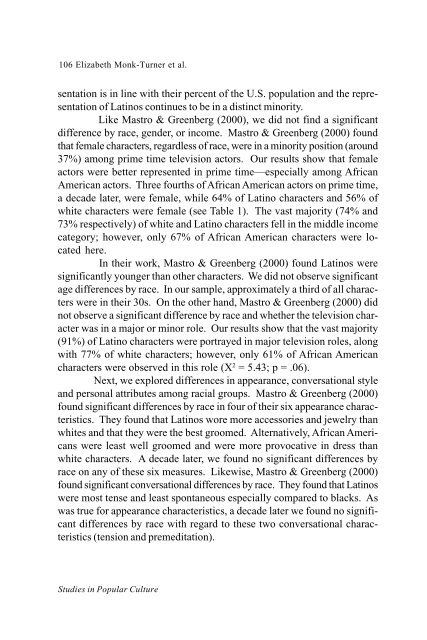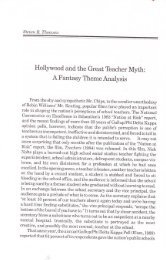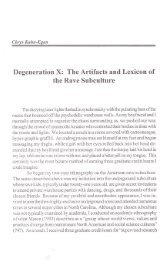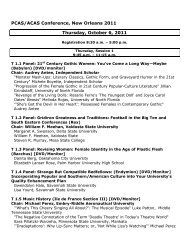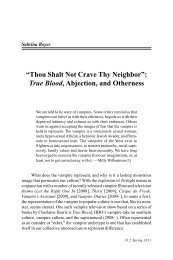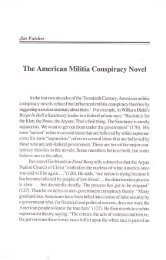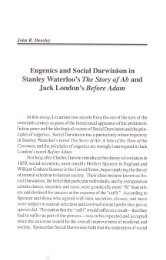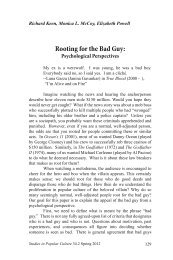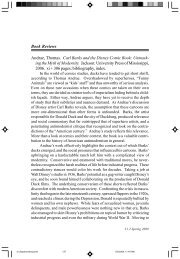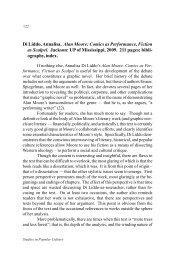The Portrayal of Racial Minorities on Prime Time Television: A ...
The Portrayal of Racial Minorities on Prime Time Television: A ...
The Portrayal of Racial Minorities on Prime Time Television: A ...
Create successful ePaper yourself
Turn your PDF publications into a flip-book with our unique Google optimized e-Paper software.
106 Elizabeth M<strong>on</strong>k-Turner et al.<br />
sentati<strong>on</strong> is in line with their percent <str<strong>on</strong>g>of</str<strong>on</strong>g> the U.S. populati<strong>on</strong> and the representati<strong>on</strong><br />
<str<strong>on</strong>g>of</str<strong>on</strong>g> Latinos c<strong>on</strong>tinues to be in a distinct minority.<br />
Like Mastro & Greenberg (2000), we did not find a significant<br />
difference by race, gender, or income. Mastro & Greenberg (2000) found<br />
that female characters, regardless <str<strong>on</strong>g>of</str<strong>on</strong>g> race, were in a minority positi<strong>on</strong> (around<br />
37%) am<strong>on</strong>g prime time televisi<strong>on</strong> actors. Our results show that female<br />
actors were better represented in prime time—especially am<strong>on</strong>g African<br />
American actors. Three fourths <str<strong>on</strong>g>of</str<strong>on</strong>g> African American actors <strong>on</strong> prime time,<br />
a decade later, were female, while 64% <str<strong>on</strong>g>of</str<strong>on</strong>g> Latino characters and 56% <str<strong>on</strong>g>of</str<strong>on</strong>g><br />
white characters were female (see Table 1). <str<strong>on</strong>g>The</str<strong>on</strong>g> vast majority (74% and<br />
73% respectively) <str<strong>on</strong>g>of</str<strong>on</strong>g> white and Latino characters fell in the middle income<br />
category; however, <strong>on</strong>ly 67% <str<strong>on</strong>g>of</str<strong>on</strong>g> African American characters were located<br />
here.<br />
In their work, Mastro & Greenberg (2000) found Latinos were<br />
significantly younger than other characters. We did not observe significant<br />
age differences by race. In our sample, approximately a third <str<strong>on</strong>g>of</str<strong>on</strong>g> all characters<br />
were in their 30s. On the other hand, Mastro & Greenberg (2000) did<br />
not observe a significant difference by race and whether the televisi<strong>on</strong> character<br />
was in a major or minor role. Our results show that the vast majority<br />
(91%) <str<strong>on</strong>g>of</str<strong>on</strong>g> Latino characters were portrayed in major televisi<strong>on</strong> roles, al<strong>on</strong>g<br />
with 77% <str<strong>on</strong>g>of</str<strong>on</strong>g> white characters; however, <strong>on</strong>ly 61% <str<strong>on</strong>g>of</str<strong>on</strong>g> African American<br />
characters were observed in this role (X 2 = 5.43; p = .06).<br />
Next, we explored differences in appearance, c<strong>on</strong>versati<strong>on</strong>al style<br />
and pers<strong>on</strong>al attributes am<strong>on</strong>g racial groups. Mastro & Greenberg (2000)<br />
found significant differences by race in four <str<strong>on</strong>g>of</str<strong>on</strong>g> their six appearance characteristics.<br />
<str<strong>on</strong>g>The</str<strong>on</strong>g>y found that Latinos wore more accessories and jewelry than<br />
whites and that they were the best groomed. Alternatively, African Americans<br />
were least well groomed and were more provocative in dress than<br />
white characters. A decade later, we found no significant differences by<br />
race <strong>on</strong> any <str<strong>on</strong>g>of</str<strong>on</strong>g> these six measures. Likewise, Mastro & Greenberg (2000)<br />
found significant c<strong>on</strong>versati<strong>on</strong>al differences by race. <str<strong>on</strong>g>The</str<strong>on</strong>g>y found that Latinos<br />
were most tense and least sp<strong>on</strong>taneous especially compared to blacks. As<br />
was true for appearance characteristics, a decade later we found no significant<br />
differences by race with regard to these two c<strong>on</strong>versati<strong>on</strong>al characteristics<br />
(tensi<strong>on</strong> and premeditati<strong>on</strong>).<br />
Studies in Popular Culture


